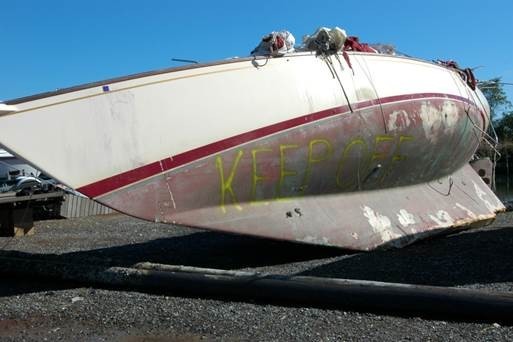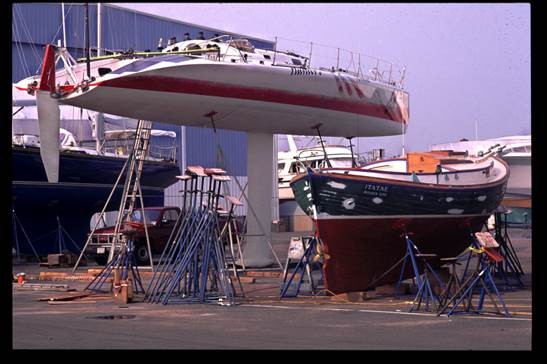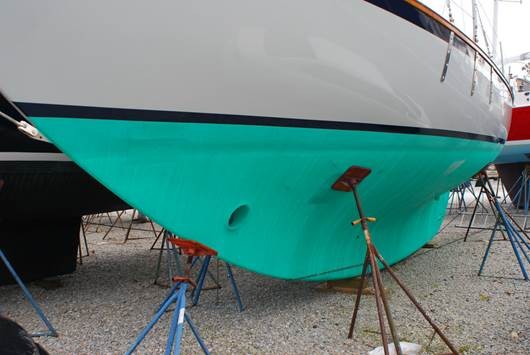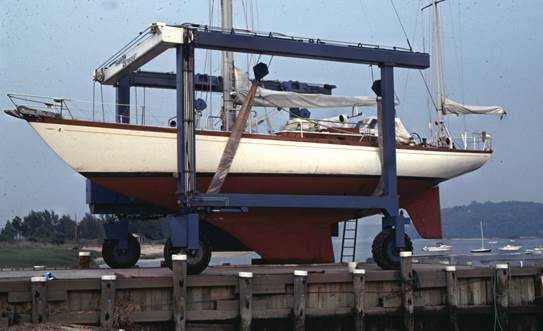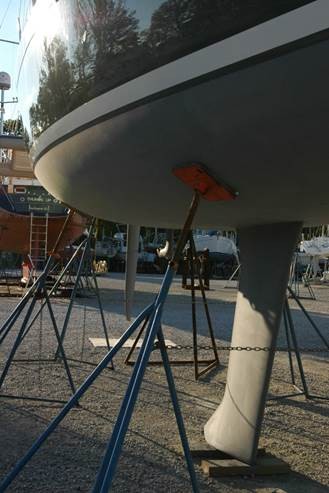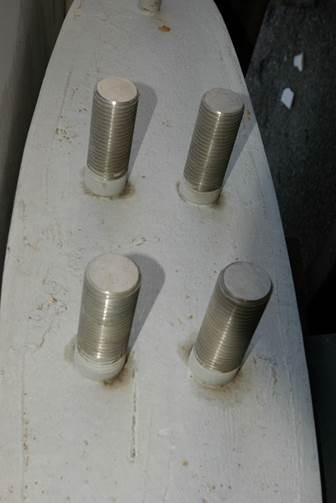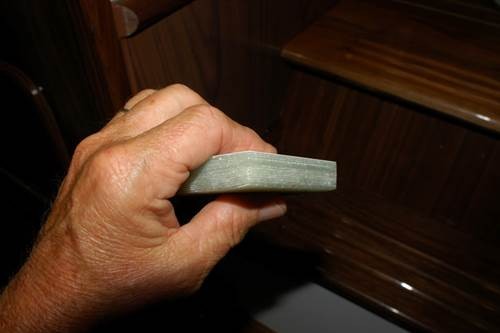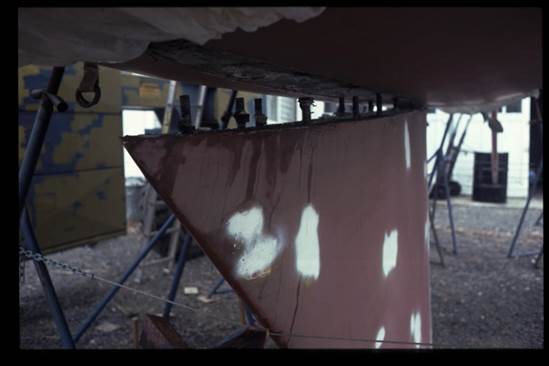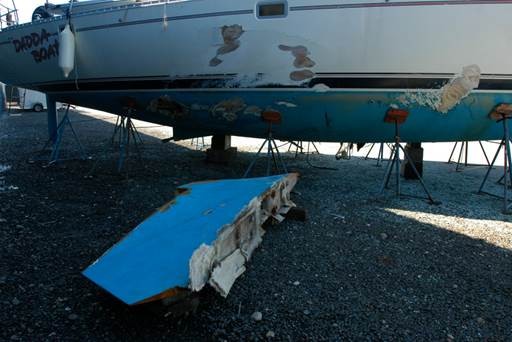Text and Photos By Ralph Naranjo
Copyright June 2014
Like bookends of keel design, these two under body extremes reflect how keel loads can be tightly focused or widely dispersed.
Most boating accidents are linked to operator error. And as tragic as these can be, there’s at least direct linkage between one’s own action and the outcome. But this ownership of the cause/effect relationship is missing when the ballast keel of a relatively new or well maintained older sailboat suddenly parts company with the hull, and in more cases than not, precipitates a near instantaneous capsize.
Around Alone single- hander Tim Kent sailed his 50-footer Everest Horizontal to a second place finish in one of the most grueling sailboat races on the planet. But during a subsequent double handed return race from Bermuda to Newport, he and Rick McKenna had a different kind of bad luck-good luck encounter.
Single-hander Tim Kent experienced a keel loss aboard Everest Horizontal.
Less than a day out of Bermuda, they heard two gut wrenching bangs as tortured metal let go and the beamy sloop quickly inverted sans lead ballast bulb. Sputtering to the surface with a container of flares, the two man crew of the now inverted, “Everest Horizontal” were elated to see a brightly illuminated cruise ship off in the distance. The rocket flares did their thing and within minutes the ship was on station and a rescue was in progress. Had the timing been different, the two sailors would have had only the overturned, nearly awash hull as their island of refuge. In many cases, a life raft stowed aboard an upside down hull becomes inaccessible; even with a hydrostatic release, there’s no guarantee that the raft will clear collapsed rigging, lifelines and other deck and cockpit encumbrances.
The bottom line is a keel-to-hull junction needs to be engineered with enough of a safety margin to keep normal and abnormal “sailing loads” from resulting in a structural failure. I don’t include a hull speed allision (a moving vessel hitting a stationary object) with a granite ledge or pounding on a rocky bottom in a surf-swept anchorage as a “sailing load”. However, the minimum structural standard should insure that keels remain contiguous with the hull for the service life of the vessel. As with standing rigging, the rudder stock and chainplates, a regular inspection process should be part of the preventative maintenance routine.
A walk through any boatyard reveals a wide range of hull shapes that aid or detract from the process of keeping the ballast connected to the hull. At one extreme are the old style cruisers euphemistically labeled “crab crushers.” They sport a stem-to-stern shallow keel which is hard to distinguish from the hull itself. When sailing to windward the crew learns patience, but these hull shapes endure sailing loads, grounding encounters and everything else short of a direct hit from floating mines. Some have internal or encapsulated ballast and rely on a skin-stressed-structure rather than keel bolts to keep the lead or iron ballast where it belongs.
Over the years keel length has been shortened, separate free standing rudders added and ballast lowered. All acceptable traits if the engineering and construction accounts for new stresses and strains.
Other sailboats utilize keel bolts to attach the ballast to the hull. More modern hull shapes trend toward a canoe body and a fin like appendage that makes up the ballast. More moderate examples have longer contact junctions at the garboard seam, while higher performing race boats incorporate increased draft, higher aspect ratio fin keels, and put the ballast at the very tip of this blade like appendage. The latter creates the most structural challenges. In essence, the keel behaves like a lengthy crowbar, wielded by an NFL tackle. The deep location of the ballast and the righting moment derived from buoyancy conspire with the wind and sea. This sets up a cycle loading process that uses the pickup truck like weight of the ballast in an attempt to flex the hull. Selecting the right materials to resist this force, and coming up with appropriate scantlings keeps engineers, naval architects and boat designers awake at night.
Keels fail for varied reasons but telltale indicators such as leaking keel bolts, cracks around the keel stub and corrosion seeping from the garboard seam can be important indicators of serious problems. I was recently delivering a lecture at a safety seminar when one of the attendees came up and shared a pretty compelling tale. He and some friends were racing a 40-footer on Eastern Long Island Sound. Fortunately, the breeze had let off and the snapping twang that signified the departure of the ballast didn’t cause the beamy sloop to capsize. In fact, the person on the poorly responding helm thought they had a rudder problem. A crew member nipped over the side to see what was up and was horrified to discover that the keel was missing. The happy ending resulted in the vessel reaching a local marina/boatyard and getting hauled for a closer inspection. Only two of the snapped off keel bolts exhibited shiny stainless steel cross section indicating that they had just fractured. All of the others were corroded and had actually fractured well before this final encounter. The point here is keels are designed and built with many different bolt patterns, metallurgy, and means of securing the bolts to the lead. A good rule of thumb for those planning to race or cruise an older boat offshore is to have the keel dropped and have a complete inspection of the bolts and keel stub carried out.
Keel bolts are most often cast into lead keels while iron keels are drilled and tapped to accept a keel bolt. Iron is lower in density and much more corrosion prone than lead, it’s a second rate choice as ballast material.
When reattaching, make sure the yard does a “dry” fit to make sure the faying surfaces make complete contact with each other. The keel bolts provide tension but it’s the surface to surface contact of the keel and the stub at the garboard seam that carries the load. Using excess seam sealant to make up for imperfections in the mated surface will lead to excess flex with each tack. In some cases a FRP fillet must be made to create the necessary machine fit.
A sample of the solid FRP laminate in the keel stub area of a well-built hull.
External ballast keel failure can be caused by issues other than keel bolt fracture. US Coast Guard photos of the recent capsize of the Beneteau 40.7 Cheeki Rafiki reveals signs of a significant hull skin failure. Enlarged holes where keel bolts and washers likely pulled completely through the hull hint of a different type of failure; one in which the hardware stayed intact but the FRP hull skin laminate and associated supporting structure failed. Photos taken at the scene also reveal a patch of outer skin peeled away during the departure of the ballast keel. Note the exposure of sandwich core material that seems to run all the way to the centerline of the vessel.
Recreational crafts are built to varying standards world wide. The Europeans have adopted an empirically based ISO standard for stability and structure, but some concerns have arisen over recent keel failures aboard boats built under these regulations. In the US, there’s a wider range to what’s deemed an appropriate scantling for an offshore racer or cruiser, more stringent guidelines are voluntary. The American Bureau of Shipping is a classification society that develops engineering and construction guidelines for shipbuilding. Their 1994 guidelines for racing yacht construction remains one of the most useful references, defining scantling minimums for essential structures such as the keel to hull attachment. In essence, they require that core material be removed and replaced with solid laminate in the vicinity of the keel to hull junction, and that this laminate be equal in thickness to the diameter of the keel bolts used. Some designers baulk at such an up-tick in safety margin, but if there’s any place to hedge your bet in sailboat building it is in keeping the keel attached to the hull.
Despite an appropriate number of 316 stainless steel keel bolts, a hard grounding can result in significant hull damage, especially on a more flat bottom hull shape.
Finally,some keel failures have had nothing to do with either keel bolt fracture or fiberglass hull inadequacy; these stem from the hardware actually losing its grip on the metal ballast itself. During lead keel construction, individual J shaped keel bolts or a combined cluster of bolts and a welded web are aligned in the keel mold before it’s flooded with molten lead. A small amount of antimony is added to the lead to make it less ductile and more inclined to hold onto the embedded keel bolts. But bad things happen when not enough antimony is added to the lead, or when the bolt and weldment surface area is inadequate. There have also been cases in which unheated stainless weldments have caused the hot mass of lead to bubble around the colder metal resulting in excess voids in the lead that later lead to failure.
Not all keel catastrophes are caused by design, material or construction shortfalls. Some years ago, I was running a boatyard and a client with a 40 foot IOR racer came home from Block Island Race Week with a big problem instead of a trophy. He and his crew knew how to make the most of a spinnaker reach, but they couldn’t seem to avoid the island’s off lying granite reefs. The allision resulted in a cannon ball size dent in the leading edge of the keel. It caused the companionway ladder to burst free of its fastenings and momentarily rise about 8 inches. Floor frames fractured, and although the hull skin had not been void, it was clear that such extreme flex hadn’t left the laminate unaffected. The repairs addressed the parts damaged and also resulted in the installation of an elaborate grid that engaged each keel bolt and spread loads in a transverse and longitudinal direction.
An encapsulated ballast keel on a vessel blown ashore in a storm, note that despite heavy damage the ballast remains intact.
An external ballast keel torn from the hull of a vessel in the same storm, note how thin the bottom laminate happens to be.
The next season a similar close encounter with Block Island occurred, but this time neither the insurance company nor my crew felt a cost effective resurrection was feasible. Those hunting for boat bargains need to watch out for such fixer uppers; a surveyor with a keen eye for spotting prior structural damage is agreat asset. Reports that extol the shine of a recent LPU paint job detail the obvious, what’s more important is the condition of the major structural aspectsof the boat— and at the top of that list is just how well the keel is attached to the hull.
Ralph Naranjo has sailed around the world, managed a boatyard, and served as the Vanderstar Chair at the US Naval Academy. Naranjo’s The Art of Seamanship delves deeper into vessel design and construction and how they relate to seaworthiness. It’s currently a pre-order on Amazon, and will become available this August.
For more information on the services provided by Steve D’Antonio Marine Consulting, Inc. please e mail Steve at info@stevedmarineconsulting.com
or call 804-776-0981

